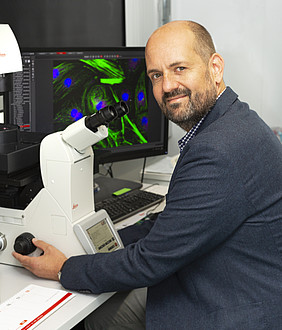Pathological deposition of connective tissue (fibrosis) is a concomitant symptom of many chronic diseases that can lead to organ failure in the medium to long term. Scientists at the European Center for Angioscience (ECAS) of the Mannheim Medical Faculty at Heidelberg University and the German Centre for Cardiovascular Research (DZHK) have identified a regulator of fibrosis in a subpopulation of endothelial cells in the transcription factor SOX9.
The work has now been published in the renowned scientific journal Science Translational Medicine. The endothelial cells lining the inside of the smallest blood vessels (capillaries) could therefore be a promising target for counteracting fibrotic diseases and organ failure.
Fibrosis is a pathological proliferation and activation of connective tissue cells that leads to an excessive deposition of connective tissue. Depending on the disease, fibrosis can occur in almost all organs. The more the functional organ tissue is displaced by connective tissue, the more the function of the affected organ is restricted.
It is undisputed that so-called fibroblasts, cells of the connective tissue that are active in division, are at the centre of fibrosis. But how is it that fibroblasts are stimulated to produce connective tissue in the course of many chronic diseases - and how can this be prevented?
For their investigations, the researchers led by Dr Felix Trogisch and Professor Dr Jörg Heineke from the Department of Cardiovascular Physiology at ECAS (Head: Prof. Heineke) used mouse models of fibrotic diseases. They found that the expression of the transcription factor SOX9 is upregulated in the capillary endothelial cells of fibrotic mouse organs.
In order to find out how important the role of SOX9 is in pathological fibrosis, the researchers wanted to investigate whether "switching off" SOX9 in the endothelium of the capillaries has a favourable effect on the disease. Indeed, the genetic silencing of SOX9 in the endothelium of mice with heart failure, liver or lung disease protected against the development of fibrosis, and organ function was preserved. Even when the disease was already advanced, it could be stopped by switching off SOX9.
Further investigations using mass and single-cell RNA sequencing shed light on the mechanism by which SOX9 acts: The transcription factor causes the endothelial cells to produce connective tissue themselves as well as to activate neighbouring fibroblasts to migrate and deposit matrix through increased production of messenger substances.
"Our results show that the smallest vascular cells actually play an important role in the development of organ fibrosis and could therefore be therapeutically modified in a targeted manner in order to counteract the pathological connective tissue and maintain organ function," explains Jörg Heineke.
"For therapeutic inhibition of endothelial SOX9, it may be an advantage that SOX9 is only switched on in a numerically small population of endothelial cells during fibrosis. It is a small cell population, but unfortunately it has a far-reaching unfavourable effect. We are now working on developing methods to therapeutically target these cells and inhibit SOX9 there," adds Felix Trogisch.
The work is further confirmation of the great importance of "angioscience" - the targeted research of the vascular system as a regulator of organ function and as a trigger for various diseases - at the European Centre for Angioscience in Mannheim and the Collaborative Research Centre 1366 "Vascular Control of Organ Function" based there.
The publication was named Paper of the Month March 2024.
Publication: Endothelial cells drive organ fibrosis and dysfunction by inducing the transcription factor SOX9. Trogisch et al. Science Translational Medicine. DOI: 10.1126/scitranslmed.abq4581
Source: press release Medical Faculty Mannheim (in German only)




